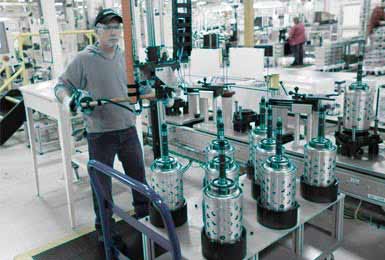Though the economic recovery is not as robust as most would like to see, manufacturing in general is leading the way, according to The Kiplinger Washington Editors’ April forecast. The auto industry, in particular, is expected to grow 4 percent this year and 5 percent in 2014, after posting astounding 19 percent growth in 2012.
KPMG found much the same sentiment in its annual survey of automotive executives. Carmakers are ramping up production to serve the American market, increasing their hiring and thinking about whether they need to construct additional capacity. The researchers say capacity is a longer-term issue worldwide, but the United States is where the crunch is most acute. Meanwhile, the forecasting firm R.L. Polk & Co. expects to see U.S. vehicle sales in the neighborhood of 15.4 million this year, about a million more than last year, and about five million more than when the industry bottomed out in 2009. The forecast grows again to top 16 million in 2014, which would be the first time that has happened since 2007.
Automakers/Suppliers Reshoring
“We went through this period when so much manufacturing was offshored; a significant amount migrated offshore,” says John Morris, leader of the Industrial Services Group for the Americas at Cushman & Wakefield. “Now we’re talking about reshoring.”
Aleksandra Miziolek, who directs the Automotive Industry Group at the Dykema law firm, says both original equipment manufacturers and suppliers are eyeing growth in America. “We are seeing an interest in coming back to the United States,” she says. “U.S. companies and suppliers had been very much interested in growing outside of the United States, primarily in Asia but also South America, Eastern Europe, etc. Everybody recognized the industry was becoming more global.”
OEMs tended to steer toward countries with lower labor and construction costs, as well as countries with enticing local markets. “A lot of companies gravitated to China and India,” she says. “But what we’re seeing now is, as you see improvement in U.S. light vehicle sales in general, you’re seeing interest by suppliers to get closer to the domestic OEMs.”
For example, some South Korean companies — as well as some from Europe —may have renewed interest in U.S. locations, she says. “This is especially true as Europe is having its difficulties. It’s not just suppliers but European manufacturers. It’s nice to see a trend coming back for increased opportunities in the United States.”
Some of the moves reflect growth in the American market, but there are other factors at work as well, says Morris. “Labor’s significance in the equation is gradually going down; the average labor cost per piece in durables manufacturing is going down,” thanks to increased automation, he points out. You can see the rise in automation by checking the stats of those companies that make the necessary equipment, he adds. “The automation industry is up 34 percent — robotics, storage and retrieval, parts picking. The headcounts associated with manufacturing are going to be declining on a per-unit basis.”
Potential U.S. growth opportunities have state and local governmental officials eager to talk, according to Miziolek. She says she saw lots of economic development networking happening at the last Center for Automotive Research Management Briefing Seminars event in Michigan. “There’s a real fight between the states. More and more you see representatives from places like Tennessee, Virginia, and Kentucky, all setting up shop and being aggressive in offering significant tax abatements or grants.”
However, it’s not just the United States that may benefit from industry growth, she adds. “Everybody is thinking pretty favorably about opportunities in North America, and Mexico seems to be a real hot spot. The work ethic is very good, and there is a significant amount of auto presence.”
Among the auto-related developments in Mexico are several at Amistad’s Industrial Park Bajio in Guanajuato, Central Mexico, including:
- Yorozu’s investment of $70 million to produce shock absorbers for Honda;
- NKP Mexico’s new 123,000-square-foot facility to provide logistics services to Honda;
- G-One’s purchase of land for a facility that will produce metal-stamped automotive doors and chassis for Honda;
- Yachiyo’s $20 million investment to produce gas tanks and sunroofs for Honda;
- Metal One’s purchase of land for a facility to supply tubes and pipes to Japanese, North American, and European automakers;
- Yutaka Technologies $40 million investment for the production of exhaust parts and motor and braking systems for motorcycles and autos;
- Tachi-S’s new facility for auto seats for OEMs in the region.
Also, in Durango, Mexico, Leoni AG is expanding the facility where the German company produces cables and wire harnesses for major auto assembly plants in Mexico.
Across the Atlantic, things are less rosy, Miziolek says. “The European problems are having an impact even on the U.S.-headquartered companies, because everyone has operations in Europe as well. People are saying Europe is not going to recover for two or three years at best. You’ll see people being extremely cautious.”
But in America, the business is running on all cylinders. Here are just a few of the significant headlines from recent months:
- Mercedes-Benz is planning a new parts consolidation center at its Alabama assembly plant that could run $70 million and create 500 jobs. The assembly operation there continues to grow, with the addition of a fourth model next year and a fifth in 2015, on top of record production last year.
- Nissan last year broke ground on an expansion at its engine plant in Decherd, Tennessee, with plans to start building an additional quarter million engines annually within a few years. Many of those engines will wind up in Mercedes-Benz C-Class sedans assembled in Alabama. Later in the year, Nissan added a third shift at its Smyrna assembly plant in Tennessee, adding more models to the mix and more than 800 names to the payroll. Nissan also announced plans to make the Sentra at its plant in Canton, Mississippi, adding about a thousand jobs.
- Chrysler is spending $374 million upgrading two Indiana transmission plants and buying and equipping another, creating more than 1,200 new jobs. The once-struggling automaker is growing elsewhere, too, including in Toledo, Ohio, where more than a thousand new jobs are tied to the manufacture of Jeep Wrangler and Cherokee models. When production is up to full speed, the company expects to make nearly half a million vehicles a year in Toledo. Chrysler also has added shifts in Detroit to make more Jeeps.
- Toyota is pumping $131 million into its Indiana assembly plant in Princeton and adding more than 400 jobs. Also in Indiana, Subaru is spending $75 million expanding its plant in Lafayette, with 100 new jobs in the works. That plant makes both Subaru and Toyota models, and company officials recently suggested more expansion may be in the offing.
- Ford is spending $200 million revamping a Cleveland, Ohio, engine plant to build turbocharged engines, with new jobs expected.
- General Motors is investing $600 million at its plant in Kansas City, Kansas.
- BMW is pumping $600 million into growing its assembly plant in Spartanburg, S.C., creating about a thousand jobs. Demand is high for the vehicles made there, up 40 percent in March compared to a year earlier.
- Kia’s $100 million expansion in West Point, Georgia, completed early last year, has led to additional shifts, with as many as a thousand new jobs resulting. The company has spent more than $1 billion on its facility there, which can turn out 360,000 vehicles a year.
All in all, industry analysts are marveling at the strength of the auto industry and the contrast with its state just a few years ago. “Clearly,” says Morris, “the health of the industry is strong.”




